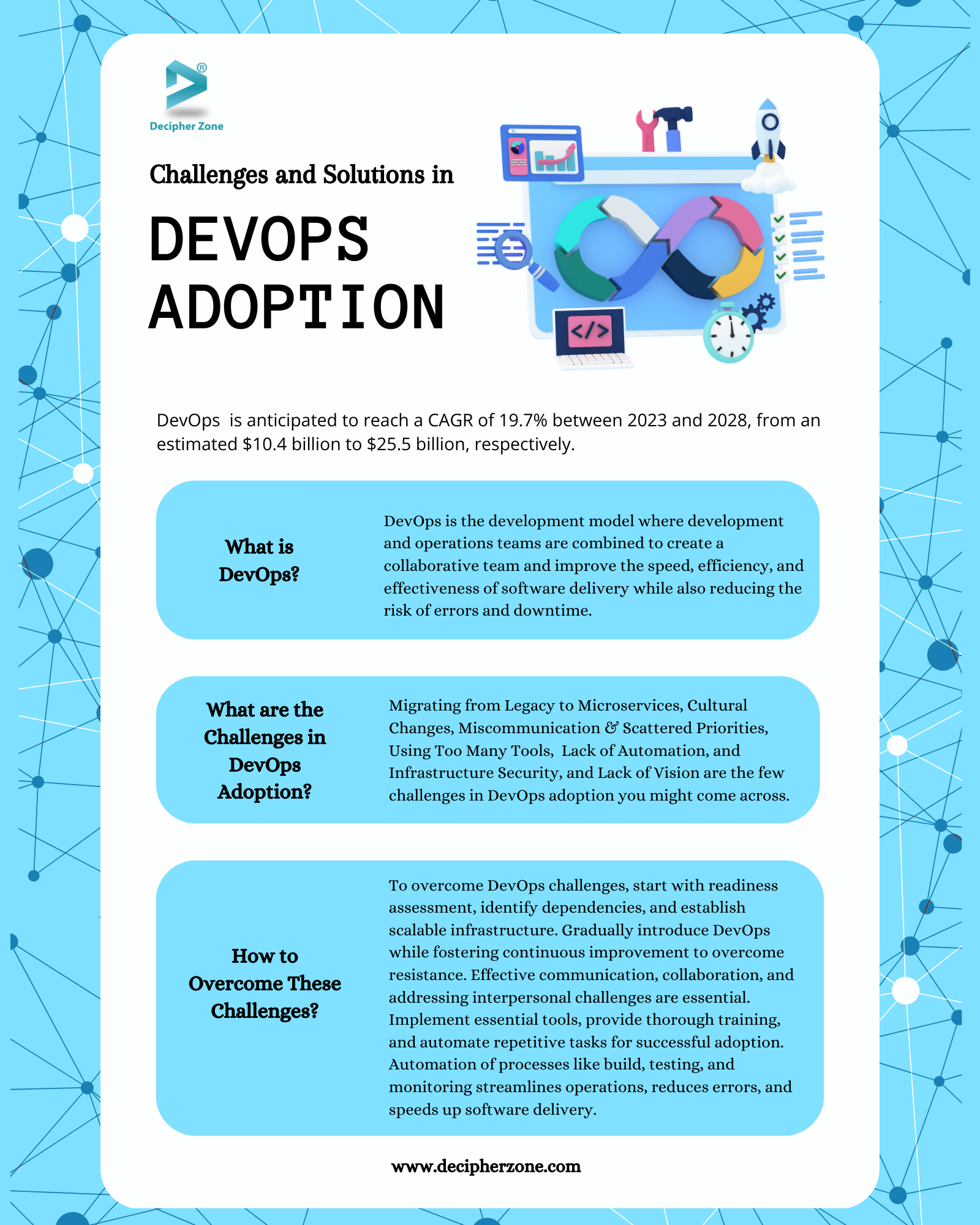
What are the common challenges that many development teams face when adopting DevOps, along with solutions to overcome them? In a DevOps approach to software development, the traditional separation of development and operations teams is eliminated and replaced by a collaborative and integrated team model.
DevOps engineers work across the entire application lifecycle, from development and testing to deployment and operations.
This approach encourages the development of a diverse skill set among team members, as they are not limited to a single function. DevOps also promotes a culture of shared responsibility for the quality and reliability of the developing software.
Read: A Guide To DevOps and Software Architecture
By breaking down silos between teams and fostering collaboration, DevOps aims to improve the speed, efficiency, and effectiveness of software delivery while also reducing the risk of errors and downtime.
Given the benefits the DevOps model brings to software development, its adoption has been snowballing. It is anticipated to reach a CAGR of 19.7% between 2023 and 2028, from an estimated $10.4 billion to $25.5 billion, respectively.
However, like other technologies and methodologies, DevOps also has challenges that should be addressed. So, in this blog, we will define DevOps challenges and how to overcome them.
Top 5 Biggest DevOps Challenges and Their Solutions
Some of the top 5 common challenges that engineers face in the initial stages of DevOps adoption are as follows:
- Migrating from Legacy to Microservices
- Resistance to Changes
- Miscommunication & Scattered Priorities
- Too Many Tools
- Lack of Automation
1. Migrating from Legacy to Microservices
Legacy apps and websites can limit the opportunities in today’s competitive market. On the other hand, microservices architecture breaks up large applications into smaller, independent services that can be built, deployed, and maintained separately.
Therefore, Microservices architecture breaks up large applications into smaller, independent services that can be built, deployed, and maintained separately. However, migrating to microservices can also be challenging due to increased complexity, the need for new tools and skills, and security risks.
Read: Best Practices & Tools for DevOps Testing Strategy
Solution
To successfully migrate to microservices, businesses should assess their readiness by analyzing their team's skills, current infrastructure, and internal priorities and policies. They should then identify logical dependencies and functionalities, choose a scalable infrastructure, migrate data, build CI/CD pipelines, and ensure that all necessary configurations and automation tools are in place.
By taking these steps, developers can better handle the challenges of adopting DevOps and improve the performance of their workloads with microservices.
2. Resistance to Changes
Although change is essential for growth, one of the common challenges that embracing DevOps brings is the resistance to change people have. It happens when people get too comfortable with following the same routine and anything that changes their routine becomes a nightmare for them. This resistance could show in the form of not wanting to learn new skills, unwillingness to work with other teams, and being unconcerned with new processes and tools.
Solution
To overcome resistance to change, businesses should avoid rushing the implementation of DevOps. Instead, they should gradually introduce it by fostering a culture of continuous improvement and learning.
This will ensure that DevOps practices become deeply ingrained in the organization's culture over time, as individuals become more familiar with these practices and principles.
Read: Essential Skills to Look for in a DevSecOps Engineer
3. Miscommunication & Scattered Priorities
DevOps often faces challenges rooted in interpersonal issues among team members. These can include grudges, misunderstandings, and stereotypes between departments. Negative conversations reflecting these tensions can disrupt the DevOps process.
Solution
Addressing these interpersonal challenges to implement DevOps successfully requires an open communication channel, promptly resolving misunderstandings, establishing common goals, promoting understanding and empathy, leading by example, encouraging collaboration, and indulging feedback mechanisms.
Read: DevOps Engineer Roadmap

4. Too Many Tools
When transitioning to DevOps, it's common to switch to different tools to automate and streamline work processes. However, integrating too many tools without proper understanding or feeling overwhelmed when selecting which ones to use can be problematic. Thus, it's crucial to avoid letting the DevOps tooling become unmanageable.
Solution
To successfully implement DevOps, start with essential tools suitable for your specific needs. Gradually introduce additional tools and ensure seamless integration to reduce errors and manual intervention. Provide comprehensive training to your teams to maximize the efficiency and benefits of the toolchain.
Read: What does DevOps actually do?
5. Lack of Automation
DevOps adoption can be hampered by manual processes. Manual techniques can slow down software development, deployment, and delivery while introducing inconsistencies and bugs.
Solution
Automating repetitive and time-consuming tasks in the DevOps pipeline is crucial to save time, reduce errors, and speed up software delivery. Some tasks that can be automated are build processes, code integrations, testing, infrastructure monitoring, and code deployment.
One of the simplest ways to achieve this is through the integration of the CI/CD pipeline as it automates code build, test, and deployment. You can also integrate Infrastructure as Code (IaC) to automate the management and monitoring of the infrastructure.
Needless to say, process automation will help reduce manual errors, save time, reduce cost, and speed up project delivery.
Read: What is Automation, Types, Benefits and Trends
Conclusion
Adopting DevOps practices has been proven to be highly beneficial in the software development industry. However, implementing DevOps requires a long-term commitment, as it involves identifying bottlenecks and challenges, and developing action plans to address them.
While we have shared some common challenges that you may encounter during your DevOps journey, there may be others that you will face. In such cases, it is recommended to tackle one issue at a time.
So, if you are seeking skilled DevOps engineers who can create agile, reliable, and secure web applications for your business, don't hesitate to contact our experts today!



























